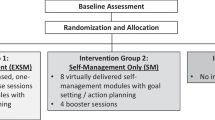Abstract
Objective: To assess how often physicians counsel patients about exercise and to identify which primary care internists infrequently counsel about it.
Design: Cross-sectional survey of a random sample of primary care internists in Massachusetts. Questions covered physicians’ attitudes, beliefs, and practices with respect to counseling about exercise; physicians’ perceived barriers to counseling about exercise; physicians’ personal exercise frequency; and physician demographics.Participants: Of 1,000 physicians, 687 were eligible and 422 returned usable questionnaires (response rate 61%).
Results: Data describing physician demographics, practice setting, measures of personal fitness, and beliefs regarding exercise were entered into a logistic regression model. The characteristic that best identified physicians who infrequently counsel about exercise was their perceived lack of success at counseling (OR 22.83, 95% CI 8.36–62.31). Other independent predictors of infrequent counseling were physicians’ lack of conviction that exercise is very important (OR4.86,95% CI 1.70–13.91), physician ages 40years (OR 308, 95% CI 1.33–7.15), and higher physician resting heart rate (OR 345, 95% CI 1.46–8.18).
Conclusions: Several factors were found to be independently associated with the likelihood of a physician’ counseling about exercise. These included physician perceived success at counseling, physician belief that exercise is important, physician age, and physician resting heart rate. These results suggest possible strategies to improve physicians’ counseling efforts.
Similar content being viewed by others
References
Harris SS, Caspersen CJ, DeFriese GH, Estes EH Jr. Physical activity counseling for healthy adults as a primary preventive intervention in the clinical setting: report of the U.S. Preventive Services Task Force. JAMA. 1989;261:3590–8.
Siscovick DS, LaPorte RE, Newman JM. The disease-specific benefits and risks of physical activity and exercise. Public Health Rep. 1985;100:180–8.
Leon AS, Connett J, Jacobs DR Jr, Rauramaa R. Leisure-time physical activity levels and risk of coronary heart disease and death: the Multiple Risk Factor Intervention Trial. JAMA. 1987;258:2388–95.
Ekelund L-G, Haskell WL, Johnson JL, Whaley FS, Criqui MH, Sheps DS. Physical fitness as a predictor of cardiovascular mortality in asymptomatic North American men: the Lipid Research Clinics Mortality Follow-up Study. N Engl J Med. 1988;319:1379–84.
Blair SN, Kohl HW III, Paffenbarger RS Jr, Clark DG, Cooper KH, Gibbons LW. Physical fitness and all-cause mortality: a prospective study of healthy men and women. JAMA. 1989;262:2395–401.
Powell KE, Thompson PD, Caspersen CJ, Kendrick JS. Physical activity and the incidence of coronary heart disease. Ann Rev Public Health. 1987;8:253–87.
Paffenbarger RS Jr, Wing AL, Hyde RT, Jung DL. Physical activity and incidence of hypertension in college alumni. Am J Epidemiol. 1983;117:245–57.
Blair SN, Goodyear NN, Gibbons LW, Cooper KH. Physical fitness and incidence of hypertension in healthy normotensive men and women. JAMA. 1984;252:487–90.
Smith EL, Gilligan C, McAdam M, Ensign CP, Smith PE. Deterring bone loss by exercise intervention in premenopausal and post-menopausal women. Calcif Tissue Int. 1989;44:312–21.
Dalsky GP, Stocke KS, Ehsani AA, Slatopolksy E, Lee WC, Birge SJ Jr. Weight-bearing exercise training and lumbar bone mineral content in postmenopausal women. Ann Intern Med. 1988;108:824–8.
Greenland P, Chu JC. Efficacy of cardiac rehabilitation services: with emphasis on patients after myocardial infarction. Ann Intern Med. 1988;109:650–63.
O’Connor GT, Buring JE, Yusuf S, et al. An overview of randomized trials of rehabilitation with exercise after myocardial infarction. Circulation. 1989;80:234–44.
Doyne EJ, Ossip-Klein DJ, Bowman ED, Osborn KM, McDougall-Wilson IB, Neimeyer RA. Running versus weight lifting in the treatment of depression. J Consult Clin Psychol. 1987;55:748–54.
Carney RM, Templeton B, Hong BA, et al. Exercise training reduces depression and increases the performance of pleasant activities in hemodialysis patients. Nephron. 1987;47:194–8.
Wallace PG, Haines AP. General practitioner and health promotion: what patients think. BMJ. 1984;289:534–6.
Orleans CT, George UK, Houpt JL, Brodie KH. Health promotion in primary care: a survey of U.S. family practitioners. Prev. Med. 1985;14:636–47.
Wechsler H, Levine S, Idelson RK, Rohman M, Taylor JO. The physician’s role in health promotion—a survey of primary-care practitioners. N Engl J Med. 1983;308:97–100.
Wells KB, Lewis CE, Leake B, Schleiter MK, Brook RH. The practices of general and subspecialty internists in counseling about smoking and exercise. Am J Public Health. 1986;76:1009–13.
Wells KB, Lewis CE, Leake B, Ware JE Jr. Do physicians preach what they practice? A study of physicians’ health habits and counseling practices. JAMA. 1984;252:2846–8.
Lewis CE, Clancy C, Leake B, Schwartz JS. The counseling practices of internists. Ann Intern Med. 1991;114:54–8.
Becker MH (ed). The health belief model and personal health behavior. Health Educ Monogr. 1974;2:324–473.
Prochaska JO, DiClemente CC. Towards a comprehensive model of change. In: Miller WR, Heather N (eds). Treating addictive behaviors. Processes of change. New York: Plenum Press, 1986.
Kannel WB, Wilson P, Blair SN. Epidemiological assessment of the role of physical activity and fitness in development of cardiovascular disease. Am Heart J. 1985;109:876–85.
Russell MAH, Wilson C, Taylor C, Baker CD. Effect of general practitioners’ advice against smoking. BMJ. 1979;2:231–5.
Wilson DM, Taylor DW, Gilbert JR, et al. A randomized trial of a family physician intervention for smoking cessation. JAMA. 1988;260:1570–4.
Cummings SR, Coates TJ, Richard RJ, et al. Training physicians in counseling about smoking cessation: a randomized trial of the “Quit for Life” program. Ann Intern Med. 1989;110:640–7.
Author information
Authors and Affiliations
Additional information
Received from the Section of General Internal Medicine, Evans Memorial Department of Clinical Research, Department of Medicine, the University Hospital, Boston University Medical Center, Boston, Massachusetts.
Rights and permissions
About this article
Cite this article
Sherman, S.E., Hershman, W.Y. Exercise counseling. J Gen Intern Med 8, 243–248 (1993). https://doi.org/10.1007/BF02600089
Issue Date:
DOI: https://doi.org/10.1007/BF02600089




